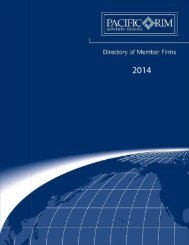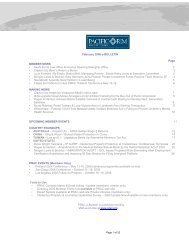A Guide to the Law of Securitisation in Australia - Clayton Utz
A Guide to the Law of Securitisation in Australia - Clayton Utz
A Guide to the Law of Securitisation in Australia - Clayton Utz
- No tags were found...
Create successful ePaper yourself
Turn your PDF publications into a flip-book with our unique Google optimized e-Paper software.
54• if <strong>the</strong> trustee has not limited its liability, <strong>the</strong> trustee mustmeet those obligations from its own assets and, if it is unable<strong>to</strong> do so, <strong>the</strong> trustee will itself be <strong>in</strong>solvent;• if <strong>the</strong> trustee has limited its liability <strong>in</strong> <strong>the</strong> manner describedabove, <strong>the</strong> trustee’s liability <strong>in</strong> respect <strong>of</strong> <strong>the</strong> obligations willbe reduced <strong>to</strong> <strong>the</strong> amount available <strong>to</strong> meet those obligationsfrom <strong>the</strong> assets <strong>of</strong> <strong>the</strong> trust and nei<strong>the</strong>r <strong>the</strong> trust nor <strong>the</strong>trustee will be <strong>in</strong>solvent; and• <strong>the</strong> direc<strong>to</strong>rs <strong>of</strong> <strong>the</strong> trustee will need <strong>to</strong> consider <strong>the</strong>possibility <strong>of</strong> be<strong>in</strong>g called upon <strong>to</strong> meet <strong>the</strong> shortfall. This isdiscussed <strong>in</strong> <strong>the</strong> next section <strong>of</strong> this publication.However, <strong>in</strong> <strong>the</strong> circumstances described <strong>in</strong> <strong>the</strong> second po<strong>in</strong>tabove, and notwithstand<strong>in</strong>g that <strong>the</strong> trustee’s liability has beenreduced, <strong>the</strong> trustee’s failure <strong>to</strong> meet <strong>the</strong> obligations <strong>in</strong> full mayhave o<strong>the</strong>r consequences, such as <strong>the</strong> accelerated repayment <strong>of</strong>pr<strong>in</strong>cipal <strong>to</strong> <strong>in</strong>ves<strong>to</strong>rs and <strong>the</strong> trigger<strong>in</strong>g <strong>of</strong> <strong>the</strong> enforcement <strong>of</strong>security given by <strong>the</strong> trustee.9.3.2 Insolvency <strong>of</strong> trusteeIf <strong>the</strong> liability <strong>of</strong> <strong>the</strong> trustee issuer has been properly limited <strong>in</strong> asecuritisation program, <strong>the</strong>n losses or liabilities <strong>in</strong>curred <strong>in</strong>respect <strong>of</strong> <strong>the</strong> trust should not cause <strong>the</strong> trustee <strong>to</strong> be personallyliable or at risk <strong>of</strong> becom<strong>in</strong>g <strong>in</strong>solvent. An exception <strong>to</strong> this willbe if <strong>the</strong> losses or liabilities were <strong>in</strong>curred due <strong>to</strong> a failure by <strong>the</strong>trustee <strong>to</strong> properly perform its duties as trustee. If <strong>the</strong>se lossesor liabilities were sufficiently large <strong>the</strong>y could cause <strong>the</strong> trustee<strong>to</strong> become <strong>in</strong>solvent. Also, a trustee could become <strong>in</strong>solvent as aresult <strong>of</strong> be<strong>in</strong>g unable <strong>to</strong> meet liabilities unconnected with <strong>the</strong>trust or <strong>the</strong> securitisation program. Typically, trustee companieswho act as issuers <strong>in</strong> securitisation programs are also trustees <strong>of</strong>many o<strong>the</strong>r trusts. A failure by <strong>the</strong> trustee company <strong>to</strong> performits obligations <strong>in</strong> relation <strong>to</strong> any <strong>of</strong> <strong>the</strong>se o<strong>the</strong>r trusts could lead<strong>to</strong> <strong>the</strong> trustee company <strong>in</strong>curr<strong>in</strong>g personal liability and,conceivably, <strong>to</strong> <strong>the</strong> <strong>in</strong>solvency <strong>of</strong> <strong>the</strong> trustee company.In general, however, <strong>the</strong> <strong>in</strong>solvency <strong>of</strong> <strong>the</strong> issu<strong>in</strong>g trustee doesnot present a serious risk <strong>to</strong> securitisation programs. This isbecause:• <strong>the</strong> assets <strong>of</strong> <strong>the</strong> trust will not be available <strong>to</strong> meet <strong>the</strong>trustee’s obligations <strong>to</strong> its general credi<strong>to</strong>rs or <strong>the</strong> credi<strong>to</strong>rs<strong>of</strong> any o<strong>the</strong>r trust; <strong>the</strong> trustee will only be entitled <strong>to</strong> be<strong>in</strong>demnified from <strong>the</strong> assets <strong>of</strong> <strong>the</strong> trust for liabilities<strong>in</strong>curred with respect <strong>to</strong> <strong>the</strong> trust; and• <strong>the</strong> trust deed will <strong>in</strong>variably provide for <strong>the</strong> trustee <strong>to</strong> bereplaced upon its <strong>in</strong>solvency and for all <strong>the</strong> assets <strong>of</strong> <strong>the</strong> trust<strong>to</strong> vest <strong>in</strong> a new trustee (usually appo<strong>in</strong>ted by <strong>the</strong> manager <strong>of</strong><strong>the</strong> securitisation program).9.4 Secured obligationsAs can been seen from <strong>the</strong> general order <strong>of</strong> priority that appliesunder <strong>the</strong> Corporations Act (as set out <strong>in</strong> section 9.2) <strong>in</strong> <strong>the</strong>absence <strong>of</strong> any security for <strong>in</strong>ves<strong>to</strong>rs upon <strong>the</strong> <strong>in</strong>solvency <strong>of</strong> acorporate issuer, claims <strong>of</strong> <strong>the</strong> <strong>in</strong>ves<strong>to</strong>rs will be satisfied aftervarious preferred claims (such as claims by employees and <strong>the</strong>costs <strong>of</strong> adm<strong>in</strong>istra<strong>to</strong>rs and liquida<strong>to</strong>rs) and proportionally with<strong>the</strong> claims <strong>of</strong> all o<strong>the</strong>r unsecured credi<strong>to</strong>rs.The same is not <strong>the</strong> case <strong>in</strong> relation <strong>to</strong> claims by <strong>in</strong>ves<strong>to</strong>rs aga<strong>in</strong>sttrust issuers. As discussed above, a trust cannot strictly speak<strong>in</strong>gbecome <strong>in</strong>solvent. In <strong>the</strong> event that <strong>the</strong> assets <strong>of</strong> <strong>the</strong> trust are notsufficient <strong>to</strong> meet <strong>the</strong> liabilities <strong>in</strong>curred by <strong>the</strong> trustee <strong>in</strong> relation<strong>to</strong> <strong>the</strong> trust:• <strong>the</strong> documentation giv<strong>in</strong>g rise <strong>to</strong> <strong>the</strong> liabilities will providethat <strong>the</strong> liabilities will be reduced, usually <strong>to</strong> <strong>the</strong> extent <strong>of</strong><strong>the</strong> trustee’s <strong>in</strong>demnity <strong>in</strong> respect <strong>of</strong> <strong>the</strong> liabilities (and if thisis not <strong>the</strong> case <strong>the</strong> trustee will be personally liable); and• <strong>the</strong> trust deed will usually provide an order <strong>of</strong> priority <strong>in</strong>which <strong>the</strong> liabilities are <strong>to</strong> be met.However, for both corporate and trust issuers, it is <strong>in</strong>variably <strong>the</strong>case that <strong>in</strong>ves<strong>to</strong>rs have <strong>the</strong> benefit <strong>of</strong> security from <strong>the</strong> issuer(usually shared with o<strong>the</strong>r credi<strong>to</strong>rs such as liquidity facility andswap providers).The security is usually a charge over all <strong>of</strong> <strong>the</strong> assets <strong>of</strong> <strong>the</strong>company (<strong>in</strong> <strong>the</strong> case <strong>of</strong> a corporate issuer) or all <strong>the</strong> assets <strong>of</strong><strong>the</strong> trust (<strong>in</strong> <strong>the</strong> case <strong>of</strong> a trustee issuer) <strong>in</strong> favour <strong>of</strong> a securitytrustee. In <strong>the</strong> case <strong>of</strong> a corporate issuer, it should be noted tha<strong>to</strong>ne <strong>of</strong> <strong>the</strong> effects <strong>of</strong> <strong>the</strong> charge be<strong>in</strong>g over all <strong>the</strong> assets <strong>of</strong> <strong>the</strong>company is that it may be enforced notwithstand<strong>in</strong>g anadm<strong>in</strong>istra<strong>to</strong>r be<strong>in</strong>g appo<strong>in</strong>ted <strong>to</strong> <strong>the</strong> company.The charge will <strong>of</strong>ten be a float<strong>in</strong>g charge over all or some <strong>of</strong> <strong>the</strong>assets. This is because <strong>the</strong> courts will not recognise a fixedcharge over assets that <strong>the</strong> chargor (<strong>the</strong> issuer) is entitled <strong>to</strong> dealwith <strong>in</strong> <strong>the</strong> ord<strong>in</strong>ary course <strong>of</strong> its bus<strong>in</strong>ess. In <strong>the</strong> case <strong>of</strong> certa<strong>in</strong>securitised assets it would be impractical <strong>to</strong> have a fixed chargebecause <strong>of</strong> <strong>the</strong> need for ongo<strong>in</strong>g deal<strong>in</strong>gs with <strong>the</strong> assets.Mortgage loans (<strong>the</strong> most commonly securitised asset <strong>in</strong><strong>Australia</strong>) must, for <strong>in</strong>stance, allow for variations, redraws andsubstitutions <strong>of</strong> <strong>the</strong> security property <strong>in</strong> order <strong>to</strong> satisfy consumerdemand.






